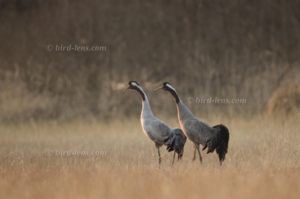 A pair of Common Cranes (Grus grus) are standing in the meadow in the twilight of dusk in Brandenburg. They obviously searched and found each other. While at the end of January an impressive migration of the cranes could be observed in Germany, arctic temperatures with two-digit minus degrees had performed over 3 weeks. The Common Cranes obviously could not impress that.
A pair of Common Cranes (Grus grus) are standing in the meadow in the twilight of dusk in Brandenburg. They obviously searched and found each other. While at the end of January an impressive migration of the cranes could be observed in Germany, arctic temperatures with two-digit minus degrees had performed over 3 weeks. The Common Cranes obviously could not impress that.
In the setting sun, they walked across a mowed wetland on the edge of a vast wetland and reed area. Again and again they walked towards each other after they had gone their own way shortly before. When they approached each other, especially when they were close together, they trumpeted their togetherness. The breath came from both throats and formed nicely visible vapor billowing in the icy cold evening air.
In addition to the rolling call, which can be heard above all from the flight formations, the Common Crane can also clearly distinguish the duet and a special warning call. The loud trumpet-like call is an unmistakable feature of the crane. Depending on the weather in open terrain calling adults can be heard more than two kilometers away.
The duet call is a timed sequence of both partners of a pair. The male usually begins, e.g. with one or two notes, and the female adds two, three, or four higher notes. When calling, the partners assume a typical posture by raising their heads and beaks. In addition, both stand close to each other or move slowly along the rows of calls. Although the duet sounds especially during the breeding season, but is also in various situations of arousal eg. presented at rest areas. Although the icy temperatures suggest otherwise, a peak of observations is currently in that time of the year – early March. Only in October / beginning of November are comparable numbers to be seen in eastern Germany.
Their enormous vocal volume is due to the special construction and the enormous length of their trachea, which runs through the sternum as a double loop. It can measure up to 130 cm. Since this long trachea has to develop in young birds, they initially only express a high-pitched whine.
However, Common Cranes have a much larger repertoire of calls. This is of great importance for intraspecific communication and social behavior. In addition to the trumpet-like reputation, which is expressed in flight as well as a warning call, the duet and a special warning call can be clearly distinguished, among a great spectrum of sounds.
To cope with the growing demand for top shots of the rarer species of the Palearctic Bird-Lens is keen to enrich the range of pictures of birds you can find in the western palearctic. Trips to remote places like this one to capture images of rare birds of western palearctic were very successful. The nice images you find in the gallery are only a first impression, what you will find in the gallery in the “Picture Shop” very soon. Just give me a message, if I could serve you with an image needed before the new pictures are online.
Other successful shootings you can see under: www.bird-lens.com in the pictures shop.